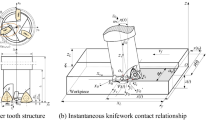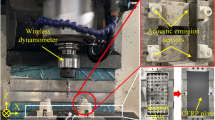Abstract
Under the influence of a high-speed, interrupted-cutting impact load, the damage degree quickly increases following any structural damage in a milling cutter. The presence of structural damage must be explored given the fact that these conditions may result in irreparable and serious accidents if not immediately detected. Milling cutter damage has multi-scale characteristics. Therefore, the single-scale damage research method cannot reveal the formation and evolution of the multi-scale damage of a milling cutter, which makes it difficult to identify and control the damage of a milling cutter. The damage scales of a milling cutter are divided according to the multi-scale characteristics of milling cutter damage. Based on continuum mechanics, the dislocation theory, and molecular dynamics, the damage characterization method of the macrostructure, lattice structure, and mesoscopic structure of a milling cutter were proposed in this study. Utilizing the multi-scale finite element method and the force connection method, the loading boundary conditions of the multi-scale damage of a milling cutter were established in order to achieve a trans-scale load transfer. The damage characteristics of the macrostructure, lattice structure, and mesoscopic structure of the milling cutter were studied, and the critical value of the multi-scale damage characteristic variable of the milling cutter was obtained. Thereby, the damage position, types, and size and damage occurrence sequences of the milling cutter were revealed, and the damage formation process and the characteristics of the milling cutter were clarified. Based on this, a method for recognizing the multi-scale damage in a milling cutter was proposed and verified by experiments. The results showed that the above method could effectively identify multi-scale damage characteristics and reveal the formation and evolution process of the damage of a high-efficiency milling cutter.
























Similar content being viewed by others
References
Deng ZH, Liu ZQ, Zhang XH (2010) Research of the science and technology development in high-speed and efficient processing field. Chin J Mech Eng 46(23):106–120
Jin G, Qi HJ, Cai YJ, Zhang QC (2016) Stability prediction for milling process with multiple delays using an improved semi-discretization method. Math Method Appl Sci 39(4):949–958
Budak E (2006) Analytical models for high performance milling. Part I: cutting forces, structural deformations and tolerance integrity. Int J Mach Tool Manu 46(12–13):1478–1488
Liu AM, Shen H, Kruth JP (2008) Influence of vibration characteristics of tool holder coupling on wear mechanism of back face in high speed milling. J Mech Eng 04:63–68
International Organization for Standardization (2002) ISO/T 15641–2001(E) Milling cutters for high speed machining-Safety requirements
Cui XB, Zhao B, Jiao F, Ming PM (2016) Formation characteristics of the chip and damage equivalent stress of the cutting tool in high-speed intermittent cutting. Int J Adv Manuf Technol 91(5):1–11
Ma L, Xiao SF, Deng HQ, Hu WY (2014) Molecular dynamics simulation of fatigue crack propagation in bcc iron under cyclic loading. Int J Fatigue 68:253–259
Shilkrot LE, Miller RE, Curtin WA (2004) Multiscale plasticity modeling: coupled atomistics and discrete dislocation mechanics. J Mech Phys Solids 52(4):755–787
Chandran KSR, Chang P, Cashman GT (2010) Competing failure modes and complex S-N curves in fatigue of structural materials. Int J Fatigue 32(3):482–491
Li J, Ren XD (2011) Multi-scale based stochastic damage evolution. Eng Fail Anal 2:726–734
Luo C, Chattopadhyay A (2011) Prediction of fatigue crack initial stage based on a multiscale damage criterion. Int J Fatigue 33(3):403–413
Zhao ZF, Chu FL (2017) Molecular dynamics simulation of crack initiation and propagation in bcc iron under load within spur gear tooth root. Fatigue Fract Eng M 41(2):323–335
Bai YL, Bai J, Li HL (2000) Damage evolution, localization and failure of solids subjected to impact loading. Int J Impact Eng 24(6–7):685–701
Tao HJ, Yin J (2007) Material design hierarchy theory and related issues across scales. Mater Sci Eng Powder Metall 12(5):264–271
Allendorf MD, Stavila V (2015) Crystal engineering, structure-function relationships, and the future of metal-organic frameworks. Crystengcomm 17(2):229–246
Leukart M, Ramm E (2003) A comparison of damage models formulated on different material scales. Comput Mater Sci 28(3–4):0–762
Kaczmarek J (2015) A method of multiscale modelling considered as a way leading to unified mechanics of materials. Acta Mech 226(5):1419–1443
Bai JX, Bai QS, Tong Z (2016) Evolution of surface grain structure and mechanical properties in orthogonal cutting of titanium alloy. J Mater Res 31(24):3919–3929
Ghandehariun A, Kishawym HA, Umer U, Hussein HM (2016) Analysis of tool-particle interactions during cutting process of metal matrix composites. Int J Adv Manuf Technol 82(1):143–152
Feng Y, Wang ML, Wang BS, Hou JM (2014) Research on cutting temperature of workpiece in milling process based on WPSO. J Mech Eng 50(19):205–212
Ying L, Shi DY, Hu P, Liu WQ (2016) Numerical prediction of formability during hot forming of high strength steel based on continuum damage mechanics. Chin J Mech Eng 52(4):36–44
Li J, Fang QH, Liu YW, Zhang LC (2015) Scratching of copper with rough surfaces conducted by diamond tip simulated using molecular dynamics. Int J Adv Manuf Technol 77(5):1057–1070
Needleman A, Van de GE (2003) Discrete dislocation plasticity. Key Eng Mater 233-236(5):13–24
Zhuo XX, Liu H, Chu XH, Xu YJ (2016) A generalized multiscale finite element method for dynamic analysis of heterogeneous material. J Theor App Mech-Pol 48(02):378–386
Huang MS, Li ZH (2015) Coupled DDD-FEM modeling on the mechanical behavior of microlayered metallic multilayer film at elevated temperature. J Mech Phys Solids 85:74–97
Curtin WA, Miller RE (2003) Atomistic/continuum coupling in computational materials science. Model Simul Mater Sci 11(3):33–36
Liang YC, Pen HM, Bai QS, Lu LH (2011) Multiscale simulation of nanometric cutting of single crystal cu based on bridging domain method. Acta Phys Sin-CH 60(10):30–35
Xiao SP, Belytschko T (2004) A bridging domain method for coupling continua with molecular dynamics. Comput Method Appl Mech 193(17–20):1645–1669
Funding
This work was supported by the National Natural Science Foundation of China (51875145).
Author information
Authors and Affiliations
Corresponding author
Additional information
Publisher’s note
Springer Nature remains neutral with regard to jurisdictional claims in published maps and institutional affiliations.
Rights and permissions
About this article
Cite this article
Jiang, B., Xu, X., Zhao, P. et al. Multi-scale method for recognizing damage in high-efficiency milling cutter. Int J Adv Manuf Technol 107, 2547–2562 (2020). https://doi.org/10.1007/s00170-020-05159-3
Received:
Accepted:
Published:
Issue Date:
DOI: https://doi.org/10.1007/s00170-020-05159-3




